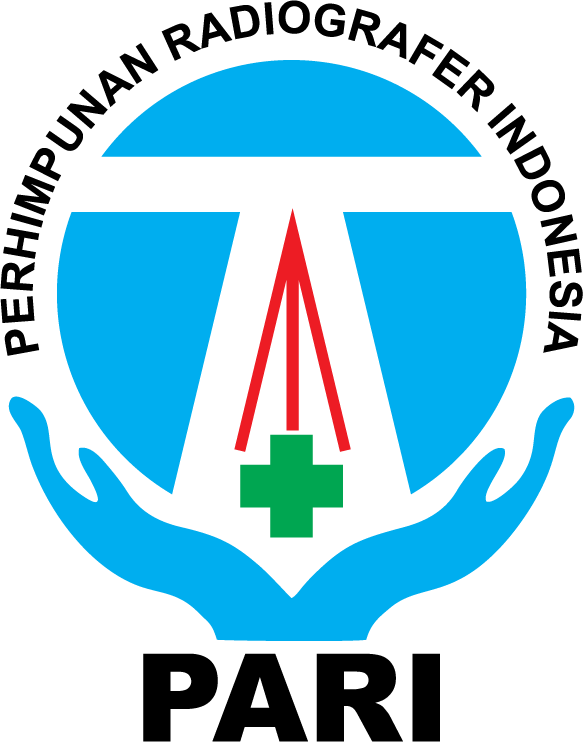Analisis Variasi Flip Angle terhadap Informasi Citra Anatomi pada Sekuen 3D TOF MRA Brain dengan MRI 3 Tesla
Abstract
Background : Magnetic Resonance Angiography is a diagnostic imaging method that can display images of blood vessels. MRA imaging on MRI 3 Tesla provides high spatial resolution making blood vessel contrast increased so that the intracranial vessels are clearer. The efficient technique that does not use contrast media in MRA is Time of Flight. 3D TOF imaging is good for visualizing intracranial vessels. In this method the appropriate flip angle will produce a hyperintense picture of the blood vessels. This study aims to determine the effect of flip angle on anatomical image information on 3D TOF MRA Brain.
Methods : This type of research is a quantitative experimental approach, conducted in February 2020 in Pertamina Central Hospital, South Jakarta. Research by conducting flip angle variations of 15°, 20°, 25°, 30° in the 3D TOF sequence of the Brain against 10 volunteers. Criteria for volunteers are healthy people aged 18-25 years. The results of the images were assessed by 3 respondent, including Internal Carotid Artery, Vertebral Artery, Basilar Artery, Anterior Cerebral Artery, Posterior Cerebral Artery, Middle Cerebral Artery, Anterior Communicating Artery, Posterior Communicating Artery. Then the Kappa test was carried out followed by the Friedman test to find the highest mean rank and comparison of flip angle in anatomical information of 3D TOF MRA Brain.
Results : The results showed that there was an effect of changes in the values of the flip angle to the anatomical information on 3D TOF MRA Brain with p < 0,05. The optimal Flip angle value is obtained based on the highest mean rank value which is flip angle 25° with a value of 3,22. The higher the value of flip angle, the greater the signal and contrast, but many slow flowing blood vessels will hypointens.
Conclussion : There are difference in anatomical image information of 3D TOF sequence among 4 variation flip angle on examination MRA Brain. Flip angle 25° is better than 15°, 20° and 30° at anatomy information on 3D TOF sequences to show intracranial artery because it has a higher mean rank value.
Keywords
Full Text:
PDFReferences
Atkinson, D., Brant-Zawadzki, M., Gillan, G., Purdy, D., & Laub, G. 1994. Improved MR angiography: Magnetization transfer suppression with variable flip angle excitation and increased resolution. Radiology, 190(3), 890–894. https://doi.org/10.1148/radiology.190.3.8115646
Born, M., Simon, B., Tschampa, H. J., Krautmacher, C., Urbach, H., Textor,
H. J., & Schild, H. H. 2003. Radiology Angiography : Comparison of 3 . 0-T Imaging and 1 . 5-T Imaging — Initial Experience 1. Radiology, (229), 913–920.
Choi, J. W., Roh, H. G., Moon, W.-J., Chun, Y. Il, & Kang, C. H. 2011.
Optimization of MR Parameters of 3D TOF-MRA for Various Intracranial Stents at 3.0T MRI. Neurointervention, 6(2), 71. https://doi.org/10.5469/neuroint.2011.6.2.71
Dale, B. M., Brown, M. A., & Semelka, R. C. 2015. MRI Basic Principles and Applications (Fifth Edit). United Kingdom: John Wiley & Sons, Ltd.
Ghazali, R. M., & Shuhaib, I. lutfi. 2003. Comparison Between 3d Tof Magnetic Resonance Angiography And Intraarterial Digital Subtraction. 10(1), 37–42.
Kapsalaki, E. Z., Rountas, C. D., & Fountas, K. N. 2012. The role of 3 Tesla MRA in the detection of intracranial aneurysms. International Journal of Vascular Medicine, 2012. https://doi.org/10.1155/2012/792834
Morelli, J. N., Gerdes, C. M., Schmitt, P., Ai, T., Saettele, M. R., Runge, V. M., & Attenberger, U. I. 2013. Technical considerations in MR angiography: An image-based guide. Journal of Magnetic Resonance Imaging, 37(6), 1326–1341. https://doi.org/10.1002/jmri.24174
Runge, V. M., Nitz, W. R., & Heverhagen, J. T. 2018. The Physics of Clinical MR Taught Through Images (Fouth Edit). New York: Thieme Medical Publishers, ,nc.
Schneider, G., Prince, M. R., Meaney, J. F. M., & Ho, V. B. (2005). Magnetic Resonance Angiography. Technique, Indications and Practical Applications. New York: Springer Milan Berlin Heidelberg.
Stuelke S. 2019. A database of MRI and MRA protocols. MRprotocols.com (diakses pada 13 Januari 2020)
Weishaupt, D., & Marincek, B. 2006. How Does MRI Work ? Second Edition.
Germany: Springer.
Westbrook, C. 2014. Handbook of MRI Technique. Fourth. India: Wiley Blackwell Ltd.
Westbrook, C., Kaut Roth, C., & Talbot, J. 2011. MRI in Practice 4th Edition. USA: Wiley Blackwell Science Ltd
DOI: https://doi.org/10.31983/jimed.v7i1.6649
Article Metrics
Refbacks
- There are currently no refbacks.
JURNAL IMEJING DIAGNOSTIK by http://ejournal.poltekkes-smg.ac.id/ojs/index.php/jimed is licensed under a Creative Commons Attribution-ShareAlike 4.0 International License.

.png)
.png)
.png)
.png)
.png)
.png)
.png)











